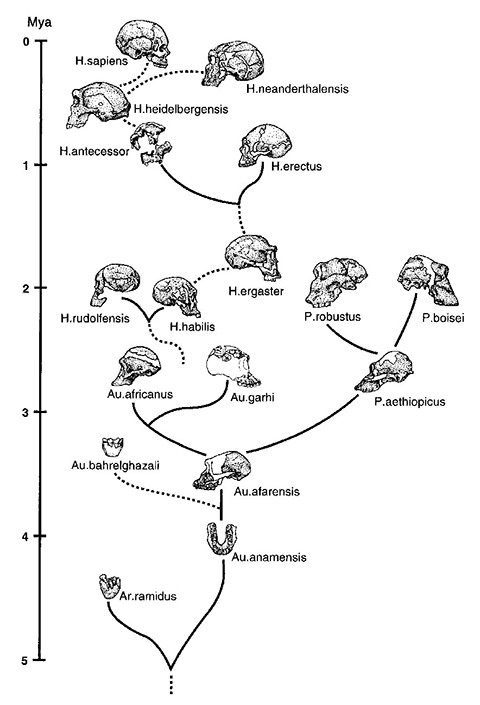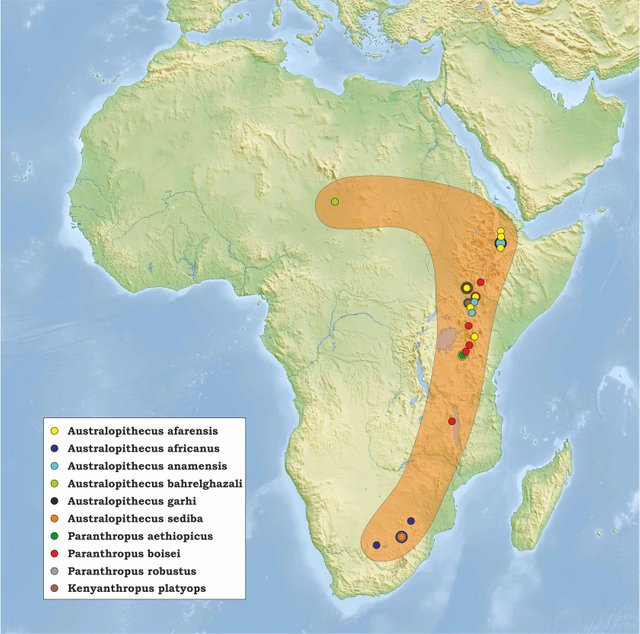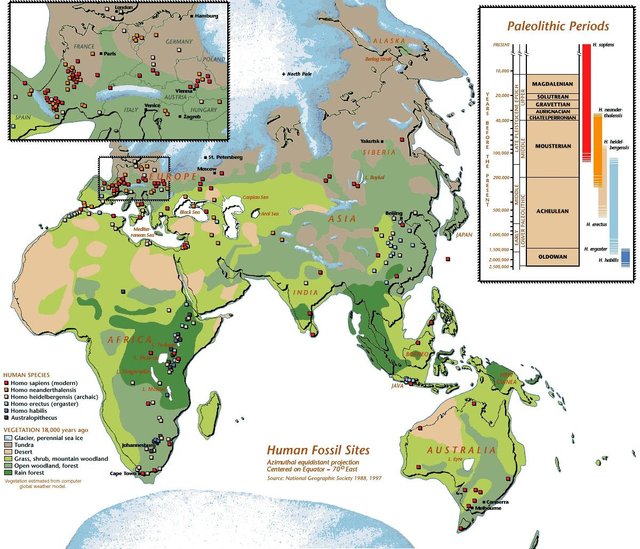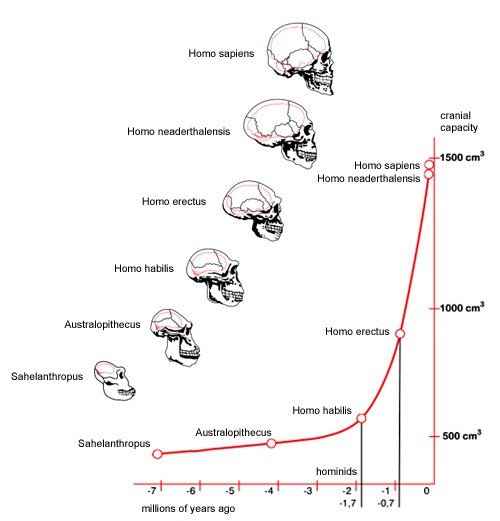Were Paranthropus our first “pets”? And dogs as “external noses”
The loss of olfactory receptors in Au. afarensis around 3.86 Ma meant that a sort of “external noses” in the form of dogs, as pets, has been valuable. Paranthropus, as a hybrid of gorillae and Au. afarensis[1], may have had much better sense of smell (at the cost of decreased memetic intelligence) and so could have been used similar to how dogs are used.
Paranthropus robustus is also heavier than afarensis and the Homo lineage, making it better at fighting off predators.
If we domesticated dogs, who domesticated us?
The Paranthropus hybrids would have been the perfect companion species, retaining the traits of the ancestral proconsul from gorillae gene transfer, while having certain adaptations for co-existing with early Homo and late Australopithecus. With a diet of stems and leaves and roots, warm fur, more robust and muscular body, and a sense of smell similar to modern day gorillas, these hybrids would have lived side-by-side with humans along the rift valley, similar to how cattle like bovines, or dogs, live side by side with humans today.
The Paranthropus would have undergone gradual domestication, with P. robustus being a derived (bred) form, and there would also be gene-flow from Paranthropus to Homo, leading to a form of unintentional self-domestication, and increased acceptance of external governance of social cognition. Eusocial intelligence in many ways requires a caste based society in order to develop, and humans as a "eusocial species of ape" (Wilson, 2012) could originate from adaptations that developed by co-existing with Paranthropus.

Machiavellian intelligence, and Paranthropus as a feedback system for that
The skills needed in imitation, i.e., putting oneself in another’s shoes and then imagining oneself doing it to achieve the same end, she argues, are exactly the skills needed in advanced social skills known as Machiavellian intelligence.
Machiavellian intelligence involves the ability to manipulate and deceive others as well as to form and dissolve alliances to achieve social or political success, and involves exactly the skills of putting oneself in the other’s shoes and taking the other’s point of view, and imagining what it would be like to be the other. This intelligence is most prominent in humans, but has been demonstrated in other primates such as rhesus monkeys (Chicago, 2007).
Co-existing with a less intelligent species, Paranthropus, could be a breeding ground for machiavellian intelligence, as they would have been more easily manipulated, as well as for breeding traits necessary for a caste based societal system which is the definition of eusocial organization (eusociality, wikipedia).

The acquisition of wolves as a new pet, and moving out of Africa
Paranthropus disappears from the fossil record around 1-2 million years ago, around the same time Homo heidelbergensis and Homo erectus migrate out of africa. H. erectus would have been excellent at traversing large distances, as they had adapted for persistence hunting, and could run for days in a row (humans still can), whereas Paranthropus would not have been very good at moving fast across large distances.
To maintain a pet as “external noses”, wolves were domesticated instead, made possible by a sort of 2 million year long practice in domestication.

Did Homo erectus have the intelligence to domesticate wolves?
What is the argument (causality) for dogs being domesticated 30,000 years ago instead of 2 million years ago? If dogs "domesticated themselves" because there was food to be found near humans, would that not be the case with Homo heidelbergensis and ergaster as well?
The brain size and intelligence has increased along an exponential curve from Au. afarensis to H. habilis, H. erectus and H. sapiens, and so if the domestication event occurred 30,000 years ago then intelligence, as well as cultural organization, would have been the factor.

A paper by Stanley Olsen [2] from 1977 mentions that “the genus Canis […] is reported from the Villafranchian (it spans a period from 3.6 to 1.2 Million years ago) or lower Pleistocene levels in North China at the archeological site of Chouchia-yu-fang.”, these may be a “small wolf or an early domestic dog (that is, a tame wolf)”, which puts the domestication event around 1.5 Ma.
If Homo erectus had the intelligence to domesticate wolves (Machiavellian intelligence) then would H. habilis have had that same intelligence? The idea of a “partner species” switch, from Paranthropus to wolves, means that the onset of the domestication of wolves was a result in a change of lifestyle (from living by the rift valley, to becoming nomadic) and that explains why wolves were not domesticated earlier (Paranthropus filled that niche already. )
Why dogs preceeded cows and sheep
Dogs are "external noses" and "external ears" and "external muscles", alarm systems, whereas sheep are "external fat" more or less, a food supply. Augmenting olfaction and similar traits had a more direct advantage to early humans, and contributed to the feedback systems that led to eusocial behaviour and over time advanced culture and technology.
References
A comparison of the human and chimpanzee olfactory receptor gene repertoires (2005)
Pair of lice lost or parasites regained: the evolutionary history of anthropoid primate lice (2007)
Insights into hominid evolution from the gorilla genome sequence (2012)
Notes
Pei (1934) and Olsen (1985) describe one possible candidate for the ancestral dog, Canis lupus variabilis. Along with C. l. pallipes, B. Lawrence (1967) mentions C. l. variabilis as a possible dog ancestor. This canid was found at Choukoudian, China, in layers dating 200,000 YBP - 500,000 YBP, associated with Homo erectus or H. sapiens artifacts, and in the layer predating Homo evidence (Kahlke & Chow 1961).
Homo habilis, which means "handy man," some 2.5 million years ago first started using stone tools. Tool making probably spread through imitation, with further refinements and changes in styles, which also spread. With tool making, the better imitators of better tool makers obviously had better chance of success. And more successful imitators of more successful people had better chance of success in survival and mating (Blackmore, 1999). The escalation in skills for making better tools and the skills to imitate the successful ones who were skillful or had high Machiavellian intelligence led to an escalation in increase in brain size in humans. And with increased brain size came increased complexity both in tools and in social structure, i.e., memes that are the basis of culture and civilization. Memes and genes for brain size and complexity must have coevolved.
Great post,,,,,,,,,
i liked ...........Thanks for sharing
Thanks for sharing this valuable information post once again :)
I've named it "the companion-species hypothesis". To test it, first the idea of afarensis-gorillae interbreeding has to be proven, and that can be done with genetic studies possibly, to look at those 15% of the human genome that are closer to gorilla than chimpanzee, and then look at the rate of neutral mutations to see if the genetic content is from 3 million years ago (hypothetical interbreeding event) or 9 million years ago (gorilla-chimpanzee-human-last-common-ancestor. )
So, if it is from hybridization, or incomplete lineage sorting (ILS)
Insights into hominid evolution from the gorilla genome sequence - nature.com (2012)